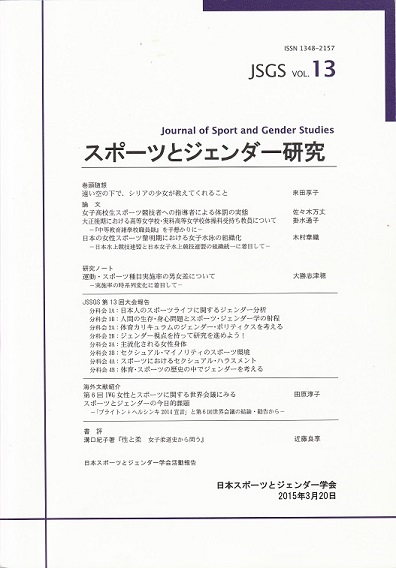Volume 13
Displaying 1-32 of 32 articles from this issue
- |<
- <
- 1
- >
- >|
-
2015 Volume 13 Pages 4-5
Published: 2015
Released on J-STAGE: April 14, 2017
Download PDF (1128K)
-
2015 Volume 13 Pages 6-23
Published: 2015
Released on J-STAGE: April 14, 2017
Download PDF (2508K) -
2015 Volume 13 Pages 24-38
Published: 2015
Released on J-STAGE: April 14, 2017
Download PDF (3419K) -
Article type: 論文
2015 Volume 13 Pages 39-55
Published: 2015
Released on J-STAGE: April 14, 2017
Download PDF (1381K)
-
Article type: 研究ノート
2015 Volume 13 Pages 56-65
Published: 2015
Released on J-STAGE: April 14, 2017
Download PDF (3117K)
-
2015 Volume 13 Pages 66-67
Published: 2015
Released on J-STAGE: April 14, 2017
Download PDF (1181K) -
2015 Volume 13 Pages 67-68
Published: 2015
Released on J-STAGE: April 14, 2017
Download PDF (1154K) -
2015 Volume 13 Pages 69-78
Published: 2015
Released on J-STAGE: April 14, 2017
Download PDF (1519K)
-
2015 Volume 13 Pages 79-80
Published: 2015
Released on J-STAGE: April 14, 2017
Download PDF (1154K) -
2015 Volume 13 Pages 80-82
Published: 2015
Released on J-STAGE: April 14, 2017
Download PDF (1294K) -
2015 Volume 13 Pages 82-
Published: 2015
Released on J-STAGE: April 14, 2017
Download PDF (1284K) -
2015 Volume 13 Pages 83-84
Published: 2015
Released on J-STAGE: April 14, 2017
Download PDF (2623K) -
2015 Volume 13 Pages 85-99
Published: 2015
Released on J-STAGE: April 14, 2017
Download PDF (1524K) -
2015 Volume 13 Pages 100-110
Published: 2015
Released on J-STAGE: April 14, 2017
Download PDF (1278K)
-
2015 Volume 13 Pages 111-122
Published: 2015
Released on J-STAGE: April 14, 2017
Download PDF (1911K)
-
2015 Volume 13 Pages 123-133
Published: 2015
Released on J-STAGE: April 14, 2017
Download PDF (4896K)
-
2015 Volume 13 Pages 134-147
Published: 2015
Released on J-STAGE: April 14, 2017
Download PDF (1264K) -
2015 Volume 13 Pages 148-158
Published: 2015
Released on J-STAGE: April 14, 2017
Download PDF (1339K)
-
2015 Volume 13 Pages 159-160
Published: 2015
Released on J-STAGE: April 14, 2017
Download PDF (1153K) -
2015 Volume 13 Pages 161-163
Published: 2015
Released on J-STAGE: April 14, 2017
Download PDF (1815K) -
2015 Volume 13 Pages 164-165
Published: 2015
Released on J-STAGE: April 14, 2017
Download PDF (1154K) -
2015 Volume 13 Pages 165-168
Published: 2015
Released on J-STAGE: April 14, 2017
Download PDF (1161K) -
Practical Research on the Acceptance of Transgendered and Female Drivers in the US Motorsports Field2015 Volume 13 Pages 169-179
Published: 2015
Released on J-STAGE: April 14, 2017
Download PDF (1246K)
-
2015 Volume 13 Pages 180-181
Published: 2015
Released on J-STAGE: April 14, 2017
Download PDF (1154K) -
2015 Volume 13 Pages 181-182
Published: 2015
Released on J-STAGE: April 14, 2017
Download PDF (1153K) -
2015 Volume 13 Pages 183-192
Published: 2015
Released on J-STAGE: April 14, 2017
Download PDF (1612K)
-
2015 Volume 13 Pages 193-194
Published: 2015
Released on J-STAGE: April 14, 2017
Download PDF (1153K) -
2015 Volume 13 Pages 194-196
Published: 2015
Released on J-STAGE: April 14, 2017
Download PDF (1205K) -
2015 Volume 13 Pages 196-198
Published: 2015
Released on J-STAGE: April 14, 2017
Download PDF (1177K) -
2015 Volume 13 Pages 199-200
Published: 2015
Released on J-STAGE: April 14, 2017
Download PDF (1171K)
-
2015 Volume 13 Pages 202-215
Published: 2015
Released on J-STAGE: April 14, 2017
Download PDF (1291K)
-
2015 Volume 13 Pages 216-218
Published: 2015
Released on J-STAGE: April 14, 2017
Download PDF (1199K)
- |<
- <
- 1
- >
- >|
